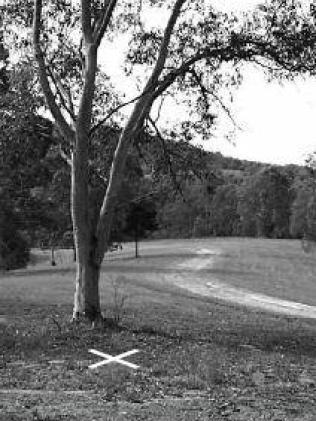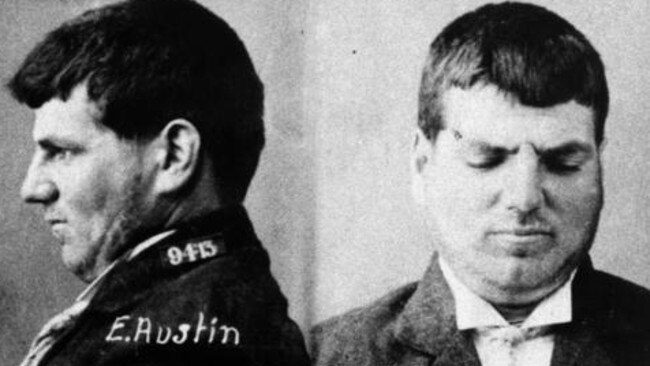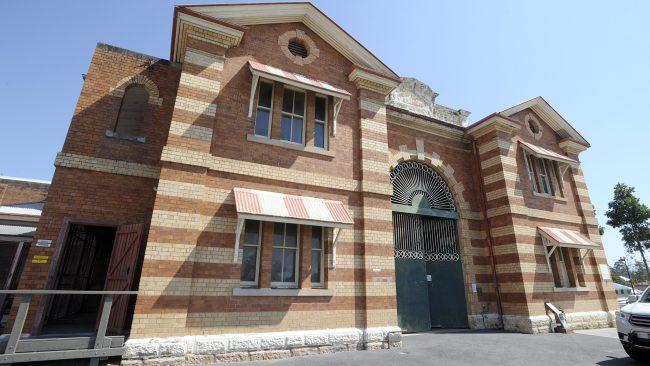Hanged child killer Ernest Austin 'in pact with the devil' at Boggo Road Gaol
IVY Mitchell was just 11 when she farewelled a young friend and walked home alone, her bare feet leaving tracks in the dust. But soon another set of prints would appear next to hers. This new set was bigger. Much bigger. A man’s boots. A killer's boots.
Our Criminal History
Don't miss out on the headlines from Our Criminal History. Followed categories will be added to My News.
THE two giggling girls skipped their way down the road, leaving tiny footprints in the dirt.
They were farmers’ daughters, one a head taller than the other.
Eleven year-old Ivy Mitchell had climbed into her parents’ sulky that morning.
They’d taken her the two miles to the Frisch property where she’d spent the day playing with the neighbours’ children.

It was June 8, 1913 — long before technology had moved children’s play indoors.
The children had spent their time in the garden — Ivy and seven-year-old Mary Frisch picking posies from wildflowers growing in the paddocks of the Samford, Queensland, property.
At 4.30pm, Mary walked Ivy down the drive.
Their little feet left tracks on the road as they made their way towards the Mitchell homestead. Two sets of footprints for two girls, side by side. After half a mile, one set of feet turned around and headed back the way they’d come.
Ivy walked on alone, clutching the posy she’d wrapped in brown paper to take home to her mother.
Soon, the single set of footprints became two once more.
This new set was bigger. Much bigger. A man’s boots.
Butcher’s boots with iron heel plates.
The pair walked together until they reached the school. Then they disappeared into the bush.
RAISING THE ALARM
JAMES Mitchell had expected his sister home long before dark.
He’d been waiting, his concern growing as the sun dropped below the horizon.
At 6pm, when Samford families were sitting down at dinner tables, he grabbed a lantern and set off on foot.
It wasn’t long before he was knocking on the door of the Frisch property.
Was Ivy there? Did they know where she was?
The neighbours shook their heads. Ivy had left two hours ago, they said.
James ran home to get his father.
Chrissie Venn: Shocking cold case haunts Aussie town
DNA: Answers prove elusive in Underbelly graves mystery
Together, James Senior and his son set off at speed, using the lantern light to follow the girls’ footprints on the road.
They followed them down the road and tracked them to the point where Mary had turned for home.
They hurried alongside the marks Ivy’s bare feet had made in the dirt.
And then they found them — the prints from a pair of Butcher’s boots, walking side-by-side with the bare footed tracks of a little girl.
They continued on, the lantern lighting the way.
At the school, the footprints disappeared.
James Senior frantically gathered neighbouring farmers, and together they searched the area.
There was thick scrub behind the school.
In the light of their lanterns, they found an area where the grass had been crushed and crumpled.
Someone had been dragged into the bushes.
A TRAGIC DISCOVERY
IVY Mitchell lay in the dirt, covered in blood.
Her killer had hacked at her throat with a knife.
The dress she wore, once blue, was now red.
She lay next to a bag of lollies and the flowers she’d picked that day with Mary.
The paper used to wrap the posy was smeared with her blood.
Part of a riding crop lay nearby. Hoof marks from a horse led away from the murder scene.
James’ lantern illuminated her little crumpled body.
His little girl, violated by a man in a pair of iron-heeled boots.

SUSPECT NAMED
DAWN arrived to find Samford swarming with police. They’d come from the city in motor cars, stationing themselves at various points to catch anyone trying to leave the area.
Boxes were placed over footprints and twigs used to mark tracks.
“SUPPOSED MURDER — SENSATION AT SAMFORD,” the headline on that day’s Brisbane Courier read.
“A terrible tragedy is reported to have taken place last night at Samford, the victim being a little girl.
“Her name is given as Ivy Mitchell, the daughter of a resident of the district and the scene of the tragedy was between Samford and the Parker State School.
“From the meagre details available last night, it is understood that the little one had been visiting some friends, and … later in the evening her dead body was found in the locality indicated.
“The metropolitan police were notified of the occurrence, and a contingent from the Depot, under Inspector Geraghty was despatched in motor cars to the scene.”
Police spoke to locals. Some had seen Ivy walking with Mary. Others had seen her alone, approaching the school.
A labourer, Alexander Gordon, was near the school at 5.30pm. He’d stolen into a garden to pick a couple of oranges from a fruit-laden tree.
He was emerging from the garden, oranges in hand, when he recognised a local farmhand, Ernest Austin, thundering past on his horse.
Austin spotted Gordon as he rode by. “Good night,” he’d said, urging his horse along with a small tree branch.
Earlier witnesses had seen Austin with a riding crop. He hadn’t had it when he’d passed Gordon.
John Lofft was another local labourer. He worked on a property with Austin and the pair shared living quarters.
The night Ivy was murdered, Austin had been in their room scraping at the sole of his boot with a knife.
“Where are the pincers kept?” he asked Lofft.
“In the blacksmith’s shop,” the labourer replied.
Austin left their room and returned a few minutes later, using the tool to tear the soles from his boots.
CRIMINAL HISTORY

POLICE moved in on June 10.
Austin was only 22, but already he’d spent plenty of time before police magistrates.
At the age of 11, he’d been caught stealing. He was sent to the Neglected Children’s Department.
In late 1909, Austin had been sentenced to three years behind bars for assault with intent to rape. The crime had been frighteningly similar to Ivy’s fate. The girl had been dragged into a shed by an axe-wielding Austin, who’d fled when she’d screamed too loudly.
Police found the soles Austin had pried from his shoes and matched them to boot prints left near Ivy’s body. They did the same with the shoes from Austin’s horse.
Police determined he’d killed the girl before fleeing to the school’s water tank where he’d washed her blood from his hands and body.
'FORGIVE ME'

A JURY took just 51 minutes to find Ernest Austin guilty of murder.
In September, three months after Ivy’s battered body was found in the bush, Austin was led to the gallows at Queensland’s infamous Boggo Road jail.
He would be the last person to hang in the state.
Soon after, Queensland became the first state to abolish the death penalty.
The newspaper men who witnessed his execution said he walked to the gallows with calm determination.
There was no trace of fear, no hint of despair, one wrote.
“I say straight out that I highly deserve this punishment,” he said, standing on the trapdoor.
“I did not know what I was doing at the time when it happened — I did not know what I was doing.
“I will say this: I dropped that bit of leather near the Parker State School, and I was going to the Samford Hotel.
“I comes back, has a cup of tea ...
“Next I stopped, and this is where I done for myself.
“I have asked the Lord to forgive me for all my faults and He has done so. I have made sorrow for my brother and sister, and not only for my own people but for the father of the child. I feel very sorry for him.”
Austin turned to look at the police superintendent before thanking him for his kindness.
His voice trembled and he paused to calm himself.
“I hope you will forgive me,” he said to the officer.
“I hope you will all live long and die happy — warders and all. God be with you.
“I did not know I would come to this grief that Sunday. No, I did not think I would come to this. I ask you all to forgive me. I ask the Samford people to forgive me; I ask my mother to forgive me. May you all live long and die happy. God save the King.”
His fellow prisoners would apparently tell a different version of the execution.
Far from reporters’ descriptions of a calm man facing his death, inmates claimed a crazed Austin had laughed hysterically as the noose was placed around his neck.

GHOST STORIES
OF the 42 inmates who faced the Boggo Road gallows, Ernest Austin would be among the hardest to forget.
For decades, claims were made of a ghostly apparition that passed through walls and into cells, strangling prisoners at night.
It was said Austin had made a pact with the devil, claiming the souls of inmates to avoid an eternity in hell.
Whether he haunted the inmates of Boggo Road is doubtful.
But he did haunt the people of Samford.
Ivy’s father would never recover from his loss. The once peaceful community became known for the bloody murder of a little girl.
- This is an edited version of a story first published in April 2015.
Originally published as Hanged child killer Ernest Austin 'in pact with the devil' at Boggo Road Gaol


